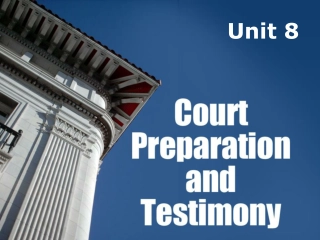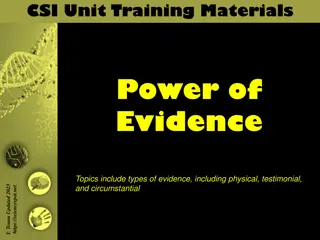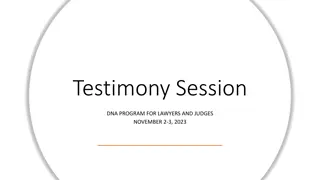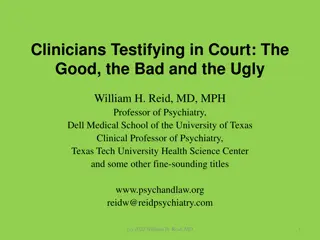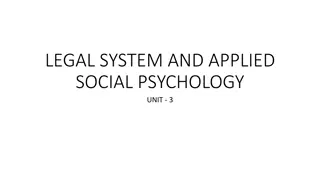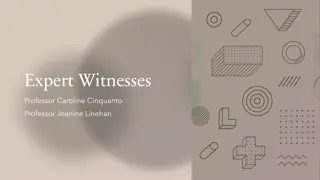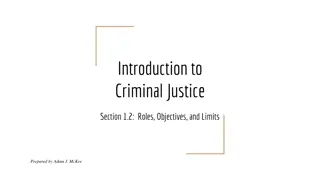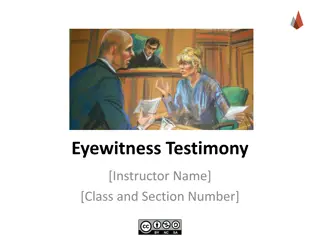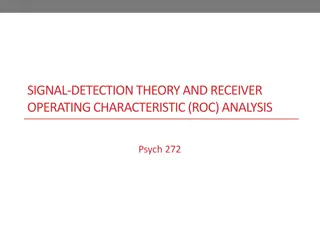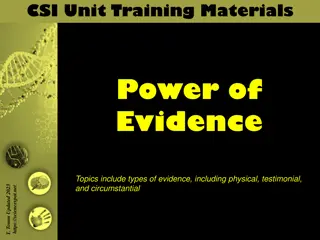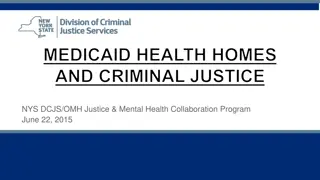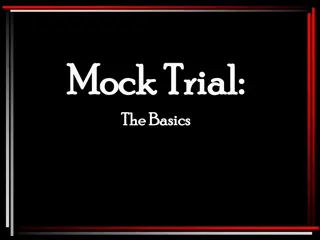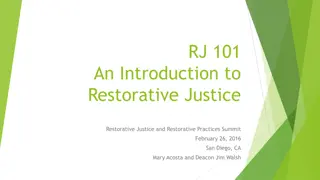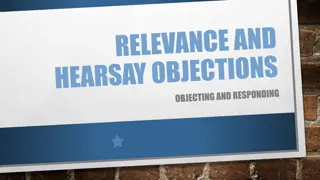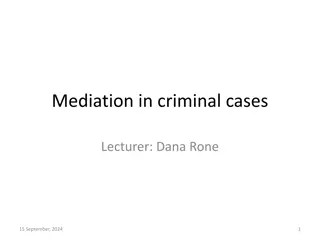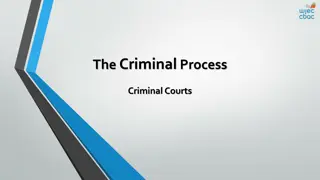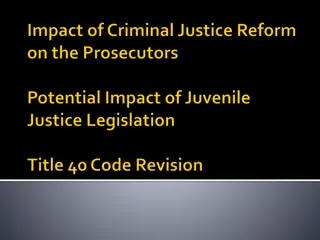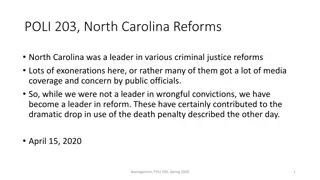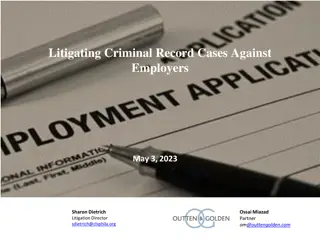Eyewitness Testimony in Criminal Justice Cases
Eyewitness testimony plays a significant role in criminal investigations and court verdicts. Two cases, one involving a wrongful conviction and the other a successful rescue, illustrate the impact of eyewitness accounts on legal outcomes. The stories of Jennifer Thompson and Mary Katherine provide insights into the complexities and challenges of relying on eyewitness evidence in the criminal justice system.
Download Presentation

Please find below an Image/Link to download the presentation.
The content on the website is provided AS IS for your information and personal use only. It may not be sold, licensed, or shared on other websites without obtaining consent from the author. Download presentation by click this link. If you encounter any issues during the download, it is possible that the publisher has removed the file from their server.
E N D
Presentation Transcript
PSYCHOLOGY OF EVIDENCE
Sec 3 IEA Evidence Fulfills the Burden of Truth Includes everything that is used to determine or demonstrate the truth of an assertion.
Sec 3 (1) IEA Eyewitness Testimony Someone who has been the spectator of an event or a crime scene, the one who can give an account of the event. 3
Role of Eyewitness Eyewitness testimony has a strong impact on criminal investigations and courtroom verdicts. Sorting out credibility and making judgements about the truth of witness statements is done by opposing counsel.
CASE 1 In 1984, Jennifer Thompson, a 22-year-old college student in North Carolina, was brutally raped at knifepoint. As she was being raped, she tried to memorize her rapist s face and physical characteristics, vowing that if she survived, she would help get him convicted. After the police were contacted, a composite sketch was made of the suspect, and Jennifer was shown six photos. She chose two, one of which was of Ronald Cotton. After looking at the photos for 4 5 minutes, she said, Yeah. This is the one, and then she added, I think this is the guy. When questioned about this by the detective who asked, You re sure? Positive? She said that it was him. She asked the detective if she did OK, and he reinforced her choice by telling her she did great. The district attorney was concerned about her lack of certainty the first time, so she viewed a lineup of seven men. She said she was trying to decide between numbers 4 and 5, finally deciding that Cotton (22 YRS), number 5, Looks most like him. By the time the trial began, Jennifer Thompson had absolutely no doubt that she was raped by Ronald Cotton. She testified at the court hearing, and her testimony was compelling enough that it helped convict him. Cotton was convicted of the rape, he was sent to prison for life plus 50 years. After 4 years in prison, he was able to get a new trial. Jennifer Thompson once again testified. After serving 11 years in prison, DNA evidence finally demonstrated that Ronald Cotton did not commit the rape, was innocent, and had served over a decade in prison for a crime he did not commit. 5
CASE 2 Elizabeth was 14 years old and fast asleep in her bed at home, she was abducted at knifepoint. Her nine-year-old sister, Mary Katherine, was sleeping in the same bed and watched, terrified, as her beloved older sister was abducted. Mary Katherine was the sole eyewitness to this crime and was very fearful. In the coming weeks, the Salt Lake City police and the FBI proceeded with caution with Mary Katherine. They did not want to implant any false memories or mislead her in any way. They did not show her police line-ups or push her to do a composite sketch of the abductor. They knew if they corrupted her memory, Elizabeth might never be found. About 4 months after the kidnapping, Mary Katherine first recalled that she had heard the abductor s voice prior to that night (he had worked one time as a handyman at the family s home) and then she was able to name the person whose voice it was. The family contacted the press and others recognized him after a total of nine months, the suspect was caught and Elizabeth Smart was returned to her family. 6
7 Assessment of Eyewitness Eyewitness testimony is crucial during a case trial. EYEWITNESS IS A HUMAN AND THUS IS SUBJECT TO ALL SORTS OF HUMAN ERRORS. EYEWITNESS MIGHT DELIBERATELY TRIES TO MISLEAD THE CASE.
APPROACHES TO THE STUDY OF EYEWITNESS ASSESSMENT Reliability and Accuracy Victim as Witness Children as Witness Sec 118 IEA : Person with legal disability can not testify as witness. Sec 134 IEA: No particular no. of witnesses are fixed by the law to prove fact.
Reliability 9 Investigators focus on information related to the actions, words, and characteristics of the perpetrator as well as to the details of the context and the roles played by other people. Eyewitness account facilitates the investigator in unwinding the truth. Thus to gain maximum from an eyewitness account the investigator has to keep questioning the reliability and accuracy of the same.
Victim as Witness 10 Witnesses may also be victims. As a victim the demands of the perpetrator and the degree of threat leveled at them increases.
Children as Witness 11 Children as eyewitness in criminal and civil legal proceedings has long been a controversial issue. Children are assumed to be less accurate and more suggestible than adults in recalling memories. Problem with young witnesses is not their ability to accurately perceive but rather in their ability to accurately and meaningfully report their recollection of these evidences.
Eyewitness Testimony Can Be Affected By Anxiety / Stress : Witnessing a real crime is probably more stressful, memory accuracy may be even more affected. Reconstructive Memory : It is a feature of human memory that we do not store information exactly as it is presented to us. In other words, people store information in the way that makes the most sense to them. We make sense of information by trying to fit it into schemas, which are a way of organizing information. 12
13 Weapon Focus : This refers to an eyewitness s concentration on a weapon to the exclusion of other details of a crime. In a crime where a weapon is involved, it is not unusual for a witness to be able to describe the weapon in much more detail than the person holding it. Leading Questions : as per Sec 141 of Indian Evidence Act means: a question asked in a way that is intended to produce a desired answer.
Confession The word confession appears for the first time in Section 24 of the Indian Evidence Act. This section comes under the heading of Admission so it is clear that the confessions are merely one species of admission. Confession is an admission made at any time by a person charged with a crime stating or suggesting the inference that he committed that crime. 16
Confession may occur in many forms For example, in Sahoo v. State of U.P. the accused who was charged with the murder of his daughter-in-law with whom he was always quarrelling was seen on the day of the murder going out of the house, saying words to the effect : I have finished her and with her the daily quarrels. The statement was held to be a confession relevant in evidence. Judicial confession- Are those which are made before a magistrate or in court in the due course of legal proceedings. A judicial confession has been defined to mean plea of guilty on arrangement (made before a court) if made freely by a person in a fit state of mind. 17
18 Extra-judicial confessions- Are those which are made by the accused elsewhere than before a magistrate or in court. It is not necessary that the statements should have been addressed to any definite individual. It may have taken place in the form of a prayer. It may be a confession to a private person. An extra-judicial confession has been defined to mean a free and voluntary confession of guilt by a person accused of a crime in the course of conversation with persons other than judge or magistrate seized of the charge against himself. Extra-judicial confession can be accepted and can be the basis of a conviction if it passes the test of credibility. Extra-judicial confession is generally made before private person which includes even judicial officer in his private capacity.
19 RETRACTED CONFESSION: Any confession which is made voluntarily is taken back or revoked, then it is known as a retracted confession. The court has the power to decide the credibility of such a confession. It differs from each case because of the facts and circumstances. If the confession is proved, then it can be considered as a base for conviction. The retracted confession can be used as legal grounds for conviction only if the court satisfies that the confession is true and it is made voluntarily. But the retracted confession should be supported by corroborative evidence.
Laws : SECTION 24 OF THE INDIAN EVIDENCE ACT Confession by an accused is induced by threat or promise will become irrelevant to criminal proceedings. If it appears to the court that the confession will result in the gain of some person who is in authority or it would avoid any evil of temporal nature, such confession is discarded from the case. The main elements of this section are The confession should be a result of inducement, threat, or promise. Such threat or inducement should flow from a person in authority. The confession should be related to the charge imposed on the accused. The confession made should either benefit a person or detriment to a person. This section does not need proof of a threat to exclude a confession, it only needs a reasonable ground to believe that there was inducement or threat or fear interfering with the confession. 20
SECTION 25 OF THE INDIAN EVIDENCE ACT Confession made before police cannot be used as evidence to prove against the accused of any offense. The confession before the police is usually considered an involuntary confession. If it is regarded as admissible, then the police would torture the accused to confess to the crime. Even if the accused has not committed the crime, he would be pressurized to confess due to the conduct of the police. So the court is restricted from using a confession before the police as grounds for conviction. If a confession is written by a person in a letter to the police, then it is admissible because the police were not present when he wrote the letter. 21
22 SECTION 26 OF THE INDIAN EVIDENCE ACT Section 26 is an extension of section 25. Section 26 prohibits the confession made by the accused in police custody. But if there is a magistrate present during the confession, then it is admissible. The magistrate under section 26 should be exercising his powers mentioned under the Code of Criminal Procedure, 1882. The freedom of the accused and voluntary nature of confession is assured when the magistrate is present. A confession made before the village head (Pradhan) in police custody is also inadmissible. The Head of the village cannot be considered as a magistrate.
SECTION 27 OF THE INDIAN EVIDENCE ACT Section 27 acts as a proviso to section 25 and 26. This section says that if a confession is supported with the discovery of any fact then it is considered as true, and such confession is admissible. If a fact is discovered as a result of the statements of the accused then the confession made by the accused can be taken to prove against him. Section 25 and 26 imposes a complete ban on confession before police, but section 27 acts as a proviso to these sections and it permits confessions that allow discovering facts in support of it. 23
24 SECTION 28 OF THE INDIAN EVIDENCE ACT If the inducement, threat, or promise mentioned under section 24 is fully removed then such confession is admissible. It can be removed by intervention by a person in authority or by lapse of time. The burden of proving that the threat has been removed is on the prosecution.
25 SECTION 29 OF THE INDIAN EVIDENCE ACT Section 29 of the act tells that confession cannot be held irrelevant in a few cases: By giving a confession statement in the promise of secrecy. By giving confession when the accused was drunk. By answering questions to which he is not bound to. No warning was given to the accused. Confessions are admissible as per section 29, even though the accused was not warned before making it or was not bound to make it.
26 SECTION 30 OF THE INDIAN EVIDENCE ACT When more than one person is jointly tried for the same offense, then the confession statement of one person bounds the other persons also. Such confession affects himself and other people who have jointly committed the offense. The word offense in this section includes abetment or attempt of an offense also. If A, B, C are jointly tried for the murder of D. Then if B gives a confessional statement that A, B, and C have done the offense jointly, then the confession affects all three persons. But confession of a co-accused cannot be taken as the sole ground for conviction of all the accused.
The confession has played a vital role in criminal law. It is a part of admission provisions in the evidence act. If confession is true and admissible in court, then it is considered satisfactory evidence to prove the guilt of the accused. Section 24 to 30 of the Evidence Act covers most of the aspects of the confession. The legal provisions regarding confession protect the accused from mistreatment and the constitutional right under Article 20(3) is also upheld. If threat or inducement is completely removed, then such confession becomes admissible. If a confession is made in police custody then it is not taken into consideration, therefore this prevents the accused from police torture. 27


